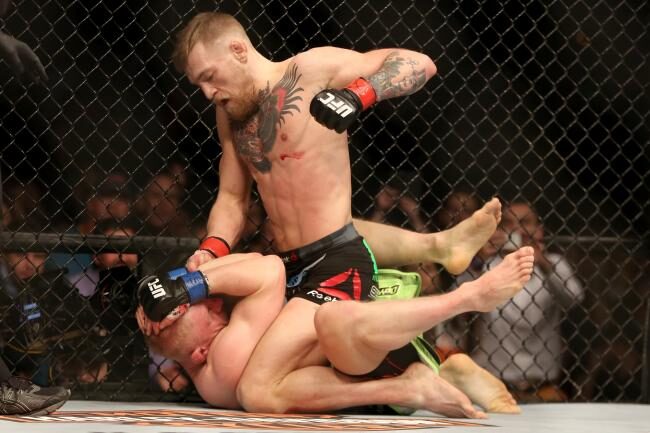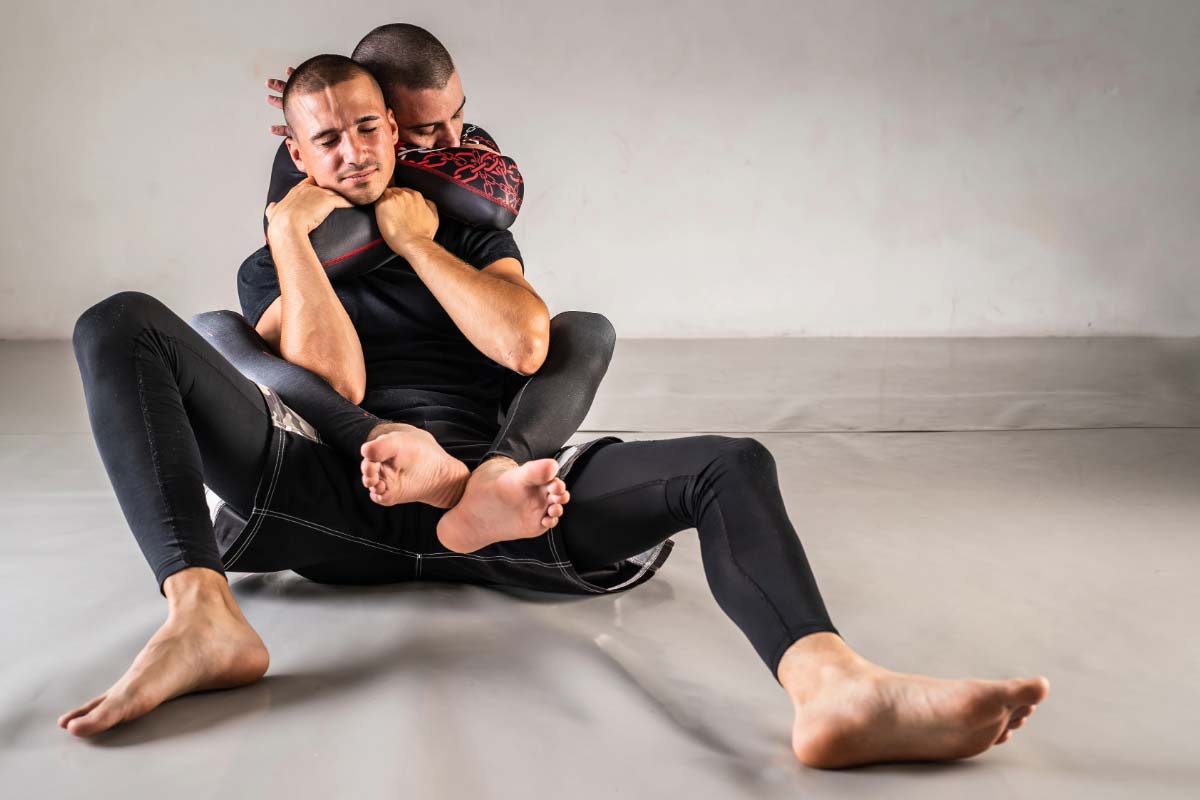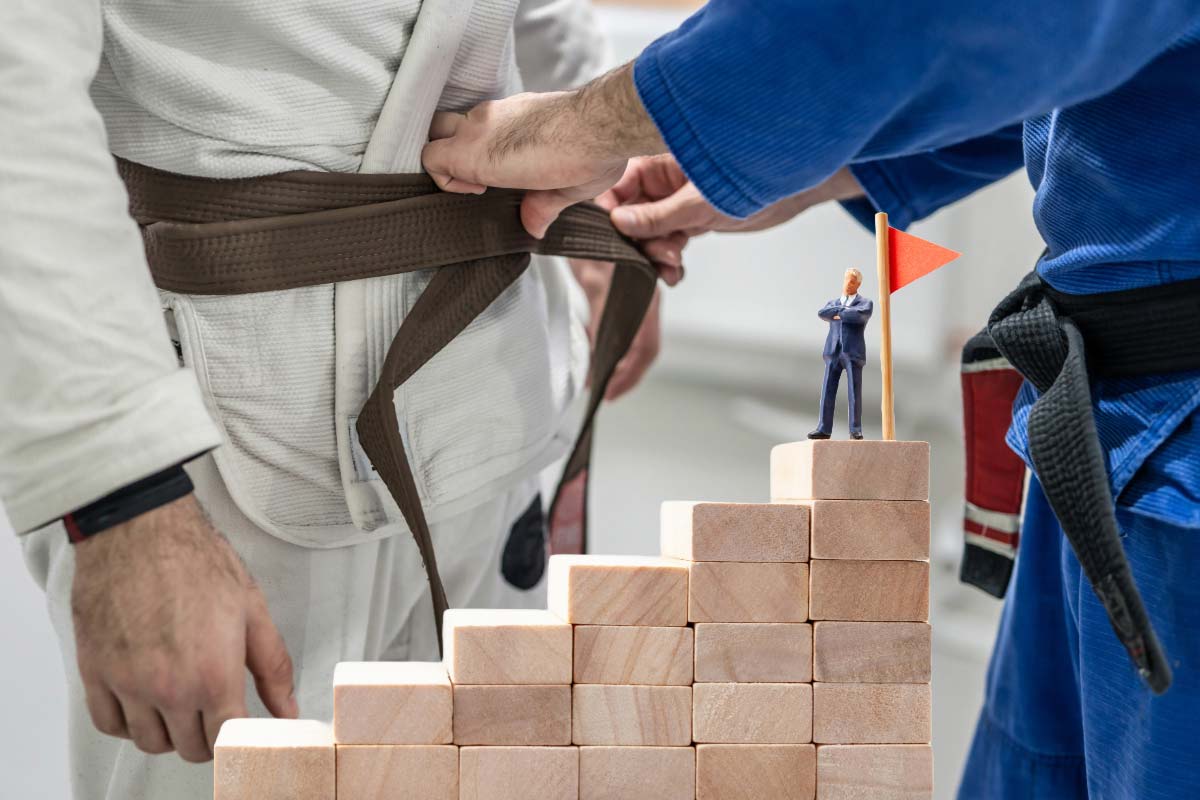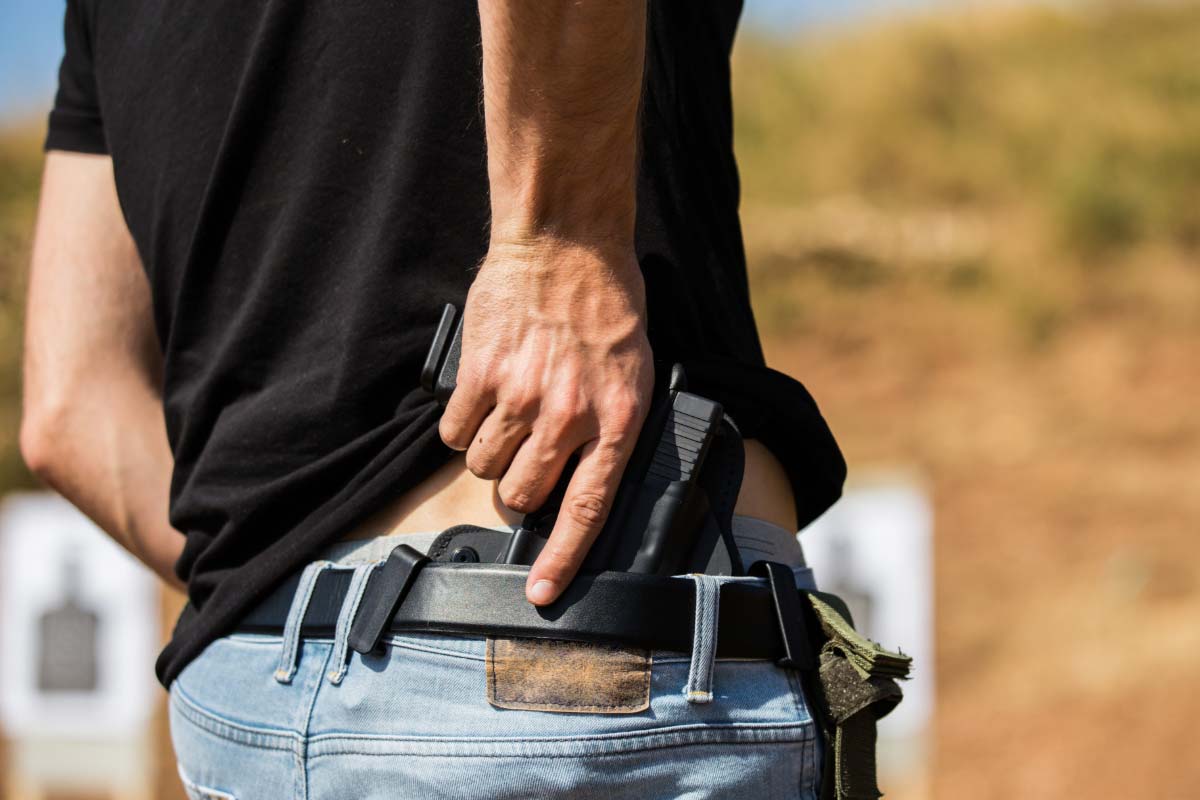Krav Maga is a self-defense system designed to prepare practitioners for a variety of attacks, combining striking and grappling techniques.
Although it’s recognized for aggressive stand-up combat, Krav Maga also includes essential skills for ground defense.
However, compared to Brazilian Jiujitsu, which specializes in ground fighting, Krav Maga’s ground techniques focus on quick disengagement.
In this exploration, we assess the ground combat effectiveness of a Krav Maga black belt and whether additional training in disciplines like Brazilian Jujitsu is necessary for a truly comprehensive self-defense skill set.
This article covers:
Krav Maga Ground Fighting Overview
Krav Maga black belts are trained to handle various combat situations with proficiency, including ground defense scenarios.
They learn a range of techniques aimed to protect themselves if taken to the ground, how to neutralize the immediate threat, and how to get back to their feet quickly. This may include defenses against common ground attacks, techniques to create space and disengage, and tactics to get up safely.
Since Krav Maga is rooted in practical self-defense, ground fighting strategies are developed to counter assaults in real-world situations on the streets rather than competitive sport grappling.
Ground techniques that black belts should know include escapes, controls, submissions, and takedowns that are pragmatic and effective. They focus on employing strikes and maneuvers that incapacitate an attacker, emphasizing the importance of quickly returning to a standing position to escape danger.
While traditional martial arts may involve more complex groundwork, Krav Maga adheres to simpler moves designed for efficacy and speed, and also a shorter training timeframe.
A Krav Maga black belt is not a grappling specialist like a Brazilian jiujitsu player or wrestler. However, their ground game is characterized by its straightforward, no-nonsense approach that aligns with the system’s overall self-defense philosophy. This focus ensures that a Krav Maga black belt can defend themselves on the ground against untrained assailants effectively.
Fundamentals of Ground Fighting in Krav Maga
Krav Maga includes ground fighting techniques designed to help a practitioner defend themselves when taken to the ground. These methods emphasize staying safe and returning to a standing position as quickly as possible.
This short video gives a great introduction to the ground fight training of a Krav Maga practitioner:
A black belt that has tested through the entire Krav Maga curriculum should have a fundamental understanding of these grappling concepts:
- Fight positions off one’s back
- Basic striking options on the ground
- Getting off the ground technically to standing
- Transition kicks while getting up
- Understanding various positions (mount, side control, guard, etc.)
- Techniques for escaping various positions (elbow escape, trap and roll, etc.)
- Headlock escapes
- Basic submissions and sweeps (arm bar, triangle chokes, sit-up sweep, etc.)
- Basic takedowns and defenses (single leg, double leg, etc.)
Krav Maga practitioners that do not supplement with additional ground training will lack the skills of a seasoned jiujitsu specialist. A pure jiujitsu practitioner will have a much deeper understanding of leverage, balance, weight distribution, transitions, different guards, and the finer details of submissions, defenses, and counters.
Importance of Ground Techniques
Ground techniques in Krav Maga are crucial because fights can quickly and often end up on the ground, despite a practitioner’s best efforts to keep the fight standing.
They focus on defensive positions and escapes. Practitioners learn how to protect themselves from various ground attacks and how to safely transition from ground to standing.
In Krav Maga, quick recovery to a standing position is stressed, as it is generally a more advantageous position for self-defense versus staying on the ground and going for submissions.
It is not designed to engage in prolonged ground fighting, as this can be dangerous in real-world self-defense scenarios where there might be multiple attackers or an unpredictable environment.
Defenses Against Common Ground Attacks
Defenses against common ground attacks in Krav Maga utilize a combination of technique, positions, and strikes to be effective.
Key defenses include:
- Escapes from inferior positions – For example, holding someone in your guard then kicking off or escaping when someone is fully mounted on top of you (shrimping, elbow escapes, buck-trap-and-roll).
- Defenses against chokes and holds – For example, escaping when someone is mounted and choking you with their arms extended or holding you down in a headlock.
- Counterattacks – For example, defending takedowns (using sprawling and sit-outs) and reversing positions as well as breaking open someone’s guard Involving targeted strikes to vulnerable areas, basic arm bars and joint locks.
These defenses enable a practitioner to respond properly to common takedowns and maintain control in most ground fighting scenarios.
Through rigorous training, a Krav Maga black belt develops well rounded defenses, and an understanding of ground fighting basics.
Training Methodologies for Ground Defense
Krav Maga approaches ground defense with strategic methodologies, emphasizing efficient movement and situational awareness. The training seeks to instill competence in defending against various ground attacks. However, the approach is not as technically refined as a pure jiujitsu ground fighting specialist.
Role of Instructors in Ground Training
Instructors are pivotal in imparting Krav Maga ground defense techniques. They tailor the training to the student’s skill level, ensuring a progressive learning curve.
Instructors focus on teaching techniques that enable students to neutralize threats swiftly. They simulate real-life situations to reinforce the student’s learning and defense mechanisms.
When incorporating ground fighting, instructors may use creative combinations of drills and techniques designed to teach students to deal with getting off the ground with urgency to prepare dealing with multiple threats.
Krav Maga Principles in Ground Fight Training
Krav Maga incorporates ground fighting training with a focus on self-defense scenarios where a practitioner may end up on the ground or starts from a disadvantaged position and needs to defend against an attacker.

Here’s an example of a Krav Maga drill that includes ground fight training:
Drill: Ground Defense Against a Mounted Attacker
Objective: To defend against an attacker who has you pinned on the ground in the mount position and is throwing punches at you.
Setup of the drill:
- Pair up with a training partner. One person will play the role of the defender, lying on their back, while the other person will be the attacker, fully mounted on top of the defender.
Steps both partners will practice:
- Defender: Start by protecting your face and head with your forearms, keeping your elbows in to also protect your body.
- Attacker: Begin to simulate strikes towards the defender’s head to create a realistic training scenario. The strikes should be controlled and not intended to injure the defender.
- Defender: Practice deflecting the strikes using your arms and hands, using the 360-degree defense technique to block outside punches and inside defenses to redirect straight punches.
- Defender: Identify the right moment to trap one of the attacker’s arms by securing it with both of your hands and pinning it to your chest. Simultaneously, trap the attacker’s corresponding foot by placing your foot over theirs to prevent them from posturing up or using their hand for base.
- Defender: Execute a bridge by lifting your hips high off the ground, using the trapped arm and foot to off-balance the attacker. Roll to the side where you’ve trapped the attacker’s limbs, reversing the position.
- Transition to Escape: Once you have reversed the position and are now on top of the attacker (or inside their guard), quickly disengage, get up to your feet and move to a safe distance.
Safety and Progression:
- The students will be instructed to start the drill slowly to ensure both partners understand the movements and can practice safely.
- The students will then gradually increase the intensity by making the aggression of strikes more realistic as both partners become more comfortable with the technique.
- Instructors may add variations, such as having the attacker grab the defender’s clothing or introducing a simulated knife to increase the complexity of the drill.
- When working in groups of three, a second attacker may be introduced in which case the defender will have a greater sense of urgency to reverse the mount, pop up, and deal with fighting the third party.
This type of drill teaches several key principles of Krav Maga ground fighting, including defending against strikes, using leverage to reverse a disadvantaged position, and the importance of quickly getting up from the ground.
Regular practice of such drills helps build muscle memory and the ability to react effectively under stress.
Sparring and Real-Life Application
Sparring sessions form a critical part of Krav Maga training, bridging the gap between practice and practical application.
Through controlled combat scenarios, students gain experience and learn to apply techniques under pressure. It’s not merely about mastery of movements but understanding the dynamics of a real confrontation.
Although Krav Maga does not incorporate a lot of kickboxing or jiujitsu specific sparring, drills often incorporate elements of sparring.
Students are also highly encouraged to cross train or take additional fight classes that allow more sparring time to develop a better sense of reaction-timing and distance management.
At higher levels in the Krav Maga system, such as green or blue belt level, extensive sparring in both stand up and ground fighting is required for belt testing.
Comparing Krav Maga to Other Martial Arts
As comprehensive self-defense system, Krav Maga contrasts noticeably with classic martial arts. It emphasizes practicality and simplicity, and being well rounded both standing and on the ground. Because of this, Krav Maga practitioners are not specialists in any single discipline.
The following subsections detail differences in ground fighting techniques and principles when compared to a traditional martial art such as Brazilian Jiu-Jitsu (BJJ) and traditional stand-up martial arts.
Ground Game in Krav Maga vs. BJJ
Brazilian Jiu-Jitsu specializes in ground fighting with a complex system of positions, submissions, escapes, sweeps, and counters.
Techniques are honed through years of training and sparring.
In contrast, Krav Maga provides a more rudimentary groundwork. It is not nearly as intricate as BJJ’s due to Krav Maga’s focus on quickly escaping or incapacitation of an opponent.
For example, where BJJ teaches methodical control positions leading to submissions, Krav Maga practitioners might use more crude techniques which may include combination of explosive movements, groin strikes or eye gouges to neutralize threats swiftly.
A highly skilled BJJ practitioner would likely be able to control and dominate a Krav Maga black belt that does not supplement their ground fighting with additional BJJ training.
Krav Maga’s Stand-Up Fighting Versus Ground Techniques
While Krav Maga encompasses ground fighting principles, it is characterized by a preference for a fighting stance that enables quick transitions between attacking and defensive maneuvers.
The stand-up combat in Krav Maga integrates techniques from various traditional martial arts like boxing, wrestling, and even some elements of Judo and Muay Thai.
Krav Maga adheres to the commitment of staying on one’s feet when possible, aiming for rapid disengagement and prioritizing situational awareness to avoid ground confrontations.
Applications and Limitations of a Krav Maga Black Belt’s Ground Techniques
Krav Maga black belts are trained in a variety of self-defense techniques aimed at neutralizing threats swiftly. Ground fighting is included, although it’s not the primary focus.
They learn to defend against attackers from a disadvantaged position and to execute counterattacks effectively. Strikes play a significant role in their ground game, aiming to incapacitate an assailant long enough to escape.
The ground techniques of Krav Maga are applied with practicality in mind. They are designed to transition from defense to attack rapidly. This is particularly relevant in real-life scenarios such as law enforcement or military engagements. A Krav Maga practitioner’s ability to disarm an armed opponent is also enhanced with ground fighting skills.
However, there are limitations. Krav Maga does not emphasize prolonged ground engagement, as its ethos is about quick disengagement and neutralization.
The system may be less detailed in ground technique compared to disciplines specifically focused on ground fighting, like Brazilian Jiu-Jitsu. Hence, Krav Maga’s range of ground techniques may be narrower with an emphasis on escaping rather than control. Positions and submissions are taught so that the student has a sense of awareness and basic understanding of various ground fighting situations.
In weapon defense, Krav Maga black belts are adept but may find it challenging against attackers skilled in ground-based grappling arts. They are trained to counterattack with strikes or to transition back to a standing position where Krav Maga techniques are most effective. These responses are context-dependent, shaped by the objective of self-preservation and escape over submission.
Do you have Krav Maga or BJJ training? What do you think about developing ground fighting skills? Leave a comment below.







